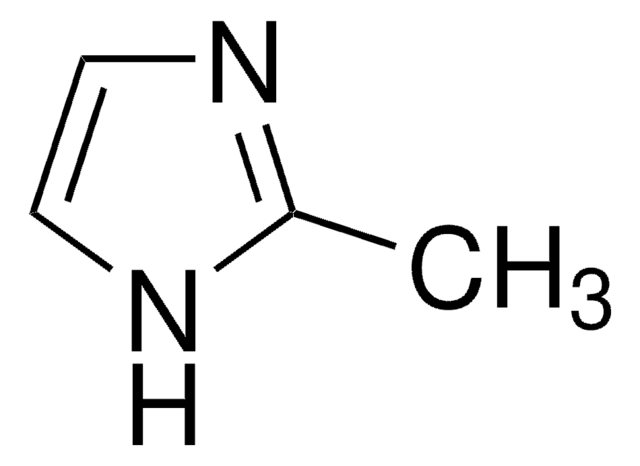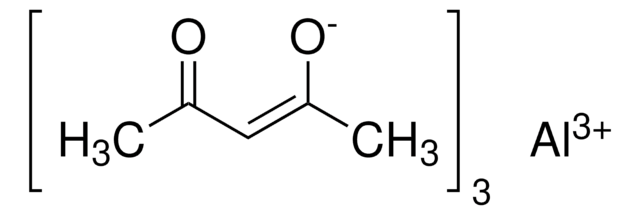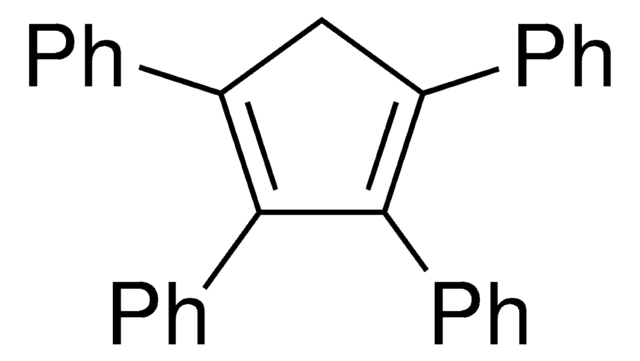517003
Iron(III) acetylacetonate
≥99.9% trace metals basis
동의어(들):
2,4-Pentanedione iron(III) derivative, Fe(acac)3, Ferric acetylacetonate, Iron(III) 2,4-pentanedionate
About This Item
추천 제품
Quality Level
분석
≥99.9% trace metals basis
양식
powder
반응 적합성
core: iron
reagent type: catalyst
mp
180-182 °C (dec.) (lit.)
density
5.24 g/mL at 25 °C (lit.)
SMILES string
CC(=O)\C=C(\C)O[Fe](O\C(C)=C/C(C)=O)O\C(C)=C/C(C)=O
InChI
1S/3C5H8O2.Fe/c3*1-4(6)3-5(2)7;/h3*3,6H,1-2H3;/q;;;+3/p-3/b3*4-3-;
InChI key
AQBLLJNPHDIAPN-LNTINUHCSA-K
유사한 제품을 찾으십니까? 방문 제품 비교 안내
일반 설명
애플리케이션
- A iron precursor for the synthesis of Fe3O4/carbon composite fibers via forcespinning technique. This composite material used in the formation of high-performance anode materials for lithium-ion batteries.
- A precursor for the synthesis of iron-containing metal-organic frameworks (MOFs) for the applications in rechargeable alkali-ion batteries.
- An additive to enhance the efficiency of the N-hydroxyphthalimide (NHPI) catalyst in the oxidation of cumene.
- A solvent activation agent in the fabrication of polyamide membranes, which are used in reverse osmosis (RO) applications.
- As a MOCVD precursor for highly crystalline (Zn,Fe)Fe2O4 films and magnetic property measurements of these films. Iron (III) acetylacetonate may be used as a precursor for the synthesis of water-soluble magnetite nanoparticles, which may find applications in magnetic hyperthermia treatment.
- As a MOCVD precursor for highly crystalline (Zn,Fe)Fe2O4 films and magnetic property measurements of these films.
신호어
Danger
유해 및 위험 성명서
Hazard Classifications
Acute Tox. 4 Dermal - Acute Tox. 4 Inhalation - Acute Tox. 4 Oral - Eye Dam. 1
Storage Class Code
11 - Combustible Solids
WGK
WGK 3
Flash Point (°F)
Not applicable
Flash Point (°C)
Not applicable
개인 보호 장비
dust mask type N95 (US), Eyeshields, Gloves
이미 열람한 고객
문서
Professor Randal Lee (University of Houston, USA) discusses design considerations for iron oxide magnetic nanospheres and nanocubes used for biosensing, including synthetic procedures, size, and shape. The effects of these variables are discussed for various volumetric-based and surface-based detection schemes.
Professor Randal Lee (University of Houston, USA) discusses design considerations for iron oxide magnetic nanospheres and nanocubes used for biosensing, including synthetic procedures, size, and shape. The effects of these variables are discussed for various volumetric-based and surface-based detection schemes.
Magnetism and magnetic materials have been of scientific interest for over 1,000 years. More recently, fundamental investigations have focused on exploring the various types of magnetic materials and understanding the magnetic effects created by electric currents.
High Purity Metalorganic Precursors for CPV Device Fabrication
자사의 과학자팀은 생명 과학, 재료 과학, 화학 합성, 크로마토그래피, 분석 및 기타 많은 영역을 포함한 모든 과학 분야에 경험이 있습니다..
고객지원팀으로 연락바랍니다.















